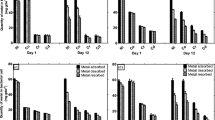Abstract
Dialysis was employed as a method of speciating heavy metals in cultures of an extracellular polymer forming strain ofKlebsiella aerogenes. A noncapsulated strain of the same bacterium was used as a control, and a mass balance of copper, cadmium, cobalt, nickel, and manganese in batch culture at pH 4.5 and pH 6.8 and in continuous culture at pH 6.8 was constructed. Copper and cadmium were accumulated by the cell during rapid proliferation whereas all 5 metals were bound nonspecifically by extracellular polymer produced during stationary phase and at low dilution rates. The presence of extracellular polymer appeared to inhibit cellular uptake of nickel. At the lower pH, metal uptake was considerably reduced. The results are discussed in the context of metal removal in the activated sludge process of waste water treatment.
Similar content being viewed by others
References
Bagby MM, Sherrard JH (1981) Combined effects of cadmium and nickel on the activated sludge process. J Wat Pollut Control Fed. 53(11):1609–1619
Beveridge TJ, Koval SF (1981) Binding of metals to cell envelopes ofEscherichia coli K-12. Appl Environ Microbiol 42(2):325–335
Bitton G, Friehofer V (1978) Influence of extracellular polysaccharides on the toxicity of copper and cadmium towardKlebsiella aerogenes. Microb Ecol 4(2):119–125
Brown MJ, Lester JN (1979) Metal removal in activated sludge: the role of bacterial extracellular polymers. Water Res 13:817–837
Brown MJ, Lester JN (1982) Role of bacterial extracellular polymers in metal uptake in pure bacterial culture and activated sludge—I Effects of metal concentration. Water Res 16:1539–1548
Brown MJ, Lester JN (1982) Role of bacterial extracellular polymers in metal uptake in pure bacterial culture and activated sludge—II Effects of mean cell retention time. Water Res 16:1549–1560
Casey JN, Wu YC (1977) Removal of copper and cadmium by metabolically controlled activated sludge. Proc 23rd Ind Waste Conf Purdue University, pp 141–152
Cheng MH, Patterson JW, Minear RA (1975) Heavy metals uptake by activated sludge. J Wat Pollut Control Fed 47:362–376
Churms SC, Stephen AM (1974) Studies of molecular-weight distribution for hydrolysis products from someKlebsiella capsular polysaccharides. Carbohyd Res 35:73–86
Corpe WA (1975) Metal binding properties of surface materials from marine bacteria. Devs Ind Microbiol 16:249–255
Dudman WF (1977) The role of surface polysaccharides in natural environments. In Sutherland I. (ed) Surface carbohydrates of the prokaryotic cell. Academic Press, London, New York, San Francisco, 357–414
Dugan PR, Pickrum HM (1972) Removal of mineral ions from water by microbially produced polymers. Proc 27th Ind Waste Conf Purdue University, Engng Ext Ser No 141(2):1019–1038
Friedman BA, Dugan PR (1968) Concentration and accumulation of metallic ions by the bacteriumZoogloea. Devs Ind Microbiol 9:381–388
Guthrie RK, Singleton FL, Cherry DS (1977) Aquatic bacterial populations and heavy metals-II Influence of chemical content of aquatic environments on bacterial uptake of chemical elements. Water Res 11:643–646
Houba C, Remacle J (1980) Composition of the saprophytic bacterial communities in freshwater systems contaminated by heavy metals. Microb Ecol 6:55–69
Hrudey SE (1981) Water reclamation and reuse. J Wat Pollut Control Fed 53(6):751–767
Khazaeli MB, Mitra RS (1981) Cadmium-binding component inEscherichia coli during accommodation to low levels of this ion. Appl Environ Microbiol 41:46–50
Lester JN, Perry R, Dadd AH (1979) The influence of heavy metals on a mixed bacterial population of sewage origin in the chemostat. Water Res 13:1055–1063
Mitra RS, Gray RH, Chin B, Bernstein IA (1975) Molecular mechanisms of accommodation inEscherichia coli to toxic levels of Cd2+. J Bacteriol 121:1180–1188
Nelson PO, Chung AK, Hudson MC (1981) Factors affecting the fate of heavy metals in the activated sludge process. J Wat Pollut Control Fed 53:1323–1333
Patrick FM, Loutit MW (1976) Passage of metals in effluents through bacteria to higher organisms. Water Res 10:333–335
Pickett AW, Dean ACR (1976) Cadmium and zinc sensitivity and tolerance inKlebsiella (Aerobacter) aerogenes. Microbios 15:79–91
Pike EB, Carrington EG (1972) Recent developments in the study of bacteria in the activated sludge process. Water Pollut Control 71:583–604
Rudd T, Sterritt RM, Lester JN (1982) The use of extraction methods for the quantification of extracellular polymer production byKlebsiella aerogenes under varying cultural conditions. Eur J Appl Microbiol Biotechnol 16:23–27
Saunders FM, Dick RI (1981) Effect of mean cell residence time on organic composition of activated sludge effluents. J Wat Pollut Control Fed 53:201–215
Slowik J (1981) Biocumulation of copper and lead bySphaerotilus natans. Acta Microbiol Polonica 30(2):183–193
Sterritt RM, Lester JN (1981) The influence of sludge age on heavy metal removal in the activated sludge process. Water Res 15:59–65
Stotzky G, Babich H (1980) Mediation of the toxicity of pollutants to microbes by the physiochemical composition of the recipient environment. Microbiology 352–354
Webb M (1970) Interrelationships between the utilization of magnesium and the uptake of other bivalent cations by bacteria. Biochim Biophys Acta 222:428–439
Author information
Authors and Affiliations
Rights and permissions
About this article
Cite this article
Rudd, T., Sterritt, R.M. & Lester, J.N. Mass balance of heavy metal uptake by encapsulated cultures ofKlebsiella aerogenes . Microb Ecol 9, 261–272 (1983). https://doi.org/10.1007/BF02097741
Issue Date:
DOI: https://doi.org/10.1007/BF02097741




